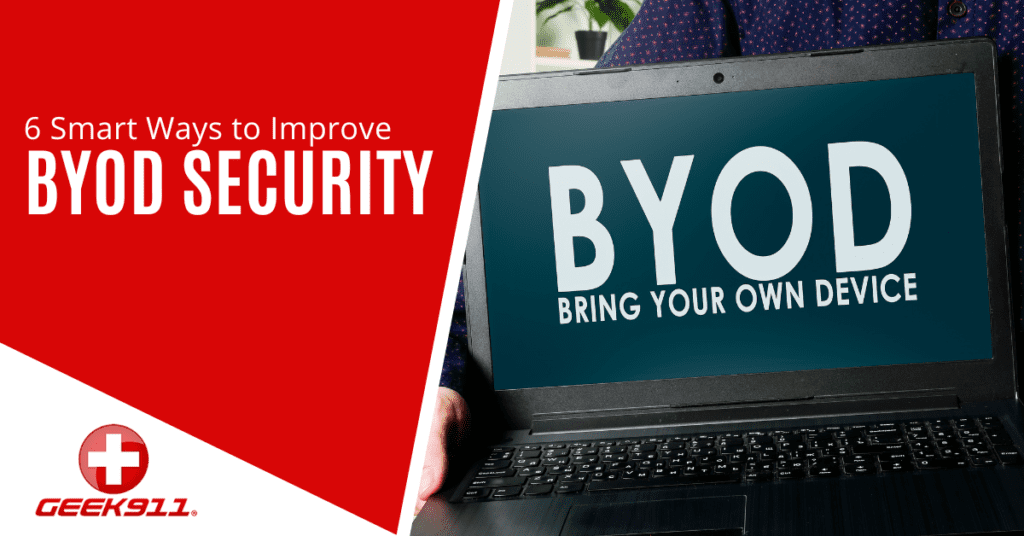6 Smart Ways to Improve BYOD Security

The BOYD market has seen a 1000% increase between 2014 and 2022 as more organizations embrace the cost benefits of enabling employees to use their own devices.
While BYOD certainly has its benefits, it also comes with risks – especially in terms of data security and privacy. In fact, over half of small businesses are worried about employees exposing company data via their personal devices.
With that in mind, here’s everything you need to know to maintain a secure environment while enabling BYOD in the workplace.
What Is BYOD?
Bring your own device (BYOD) refers to the practice of employees using their own personal devices for work purposes. With BYOD, your organization maintains ownership of the company data that resides on your employees’ devices, but the actual device belongs to the user.
Over the last few years, BYOD has grown in popularity due to a number of reasons, including:
- Enables employees to use technology they feel confident with
- Reduces costs that would otherwise be spent on hardware
- Facilitates flexible, mobile and remote working
- Helps to maintain productivity should the office environment be unable to open for unforeseen reasons
Common BYOD Challenges
BYOD presents unique security challenges that organizations must proactively address. Your company must ensure that:
- Employees obey company policies around BYOD
- Corporate data and resources on personal devices remains secure at all times
- BYOD aligns with data security regulations you are subject to, along with contractual obligations with partners, suppliers and customers
- Your BYOD program does not inhibit the privacy of the device owner
In particular, striking a balance between securing sensitive data on employee devices while maintaining privacy expectations and a good employee experience poses difficulties.
How To Improve BYOD Security
Below is a list of recommendations to help you improve your BYOD security posture. This list is aimed at both organizations who have already enabled BYOD those who are considering it.
Determine Your Objectives
The risks that arise from BYOD usage in your organization will depend entirely on how BYOD is used. You should think about how you plan to allow your employees to use BYOD and what you want to achieve by enabling it.
At the same time, make sure you develop a firm understanding of what BYOD should not be used for.
Another factor to consider is the types of devices that you will allow and the role they will play in your organization. Will you expect your employees to work solely from their own devices, or will BYOD only be used some of the time? Moreover, you’ll need to think about whether BYOD will be used for smartphones, laptops or tablets – or all of the above!
Outline Your Users
Not every employee will be suitable for inclusion in BYOD. Employees who handle highly sensitive data, for example, may be omitted from the policy. For those employees that are suitable, you’ll need to communicate your expectations around secure data interactions.
Risk Analysis
Once you know what you want to achieve with BYOD and who your users will be, it’s time to look at the security risks. Through our IT support services, we can help you with a risk analysis to identify potential security threats that arise from BYOD and put in place the right controls to keep your data secure, without hampering employee privacy or the user experience.
Develop Your BYOD Policy
With all of these components in place, it’s time to develop your BYOD policy. The aim of this is to set objectives around BYOD usage and clarify employee responsibilities.
This will mainly center around rules dictating what employees can and can’t do on their own devices with regards to work, alongside governance about what corporate data employees are allowed to interact with from their personal devices.
It’s also crucial to consider how enforceable your policies are. Is it possible that employees could circumvent the rules you’ve put in place? If so, what would the consequences be?
Enforce Your Policy
To support your policy, you will need to put in place technical controls that ensure data security, authorized access and regular patching, amongst other things. As you put these security controls in place, it’s crucial to ensure that you balance usability with data security. Otherwise, you could end up with unproductive, dissatisfied employees!
Monitor Continuously
Once you’ve rolled out your BYOD program, you’ll need to continuously monitor data usage on personal devices to prevent data breaches, leakage and meet compliance requirements.
We Can Help You With a Complete BYOD Rollout!
If you’re not sure where to start with BYOD, or need support designing and managing your program, we can help!
GEEK911 can help your Silicon Valley area business put mobile device security solutions in place, such as hard drive encryption or mobile device management. We’ll review your circumstances and offer strategic, personalized recommendations.
Schedule a consultation by calling 1-866-433-5411 or reach us online.
